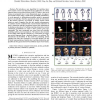Free Online Productivity Tools
i2Speak
i2Symbol
i2OCR
iTex2Img
iWeb2Print
iWeb2Shot
i2Type
iPdf2Split
iPdf2Merge
i2Bopomofo
i2Arabic
i2Style
i2Image
i2PDF
iLatex2Rtf
Sci2ools
TMM
2011
2011
MIMiC: Multimodal Interactive Motion Controller
Abstract—We introduce a new algorithm for real-time interactive motion control and demonstrate its application to motion captured data, pre-recorded videos and HCI. Firstly, a data set of frames are projected into a lower dimensional space. An appearance model is learnt using a multivariate probability distribution. A novel approach to determining transition points is presented based on k-medoids, whereby appropriate points of intersection in the motion trajectory are derived as cluster centres. These points are used to segment the data into smaller subsequences. A transition matrix combined with a kernel density estimation is used to determine suitable transitions between the subsequences to develop novel motion. To facilitate real-time interactive control, conditional probabilities are used to derive motion given user commands. The user commands can come from any modality including auditory, touch and gesture. The system is also extended to HCI using audio signals of speech in a co...
| Added | 15 May 2011 |
| Updated | 15 May 2011 |
| Type | Journal |
| Year | 2011 |
| Where | TMM |
| Authors | Dumebi Okwechime, Eng-Jon Ong, Richard Bowden |
Comments (0)

